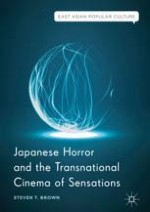2018 | OriginalPaper | Buchkapitel
5. In the Wake of Artaud: Cinema of Cruelty in Audition and Oldboy
verfasst von : Steven T. Brown
Erschienen in: Japanese Horror and the Transnational Cinema of Sensations
Aktivieren Sie unsere intelligente Suche, um passende Fachinhalte oder Patente zu finden.
Wählen Sie Textabschnitte aus um mit Künstlicher Intelligenz passenden Patente zu finden. powered by
Markieren Sie Textabschnitte, um KI-gestützt weitere passende Inhalte zu finden. powered by
